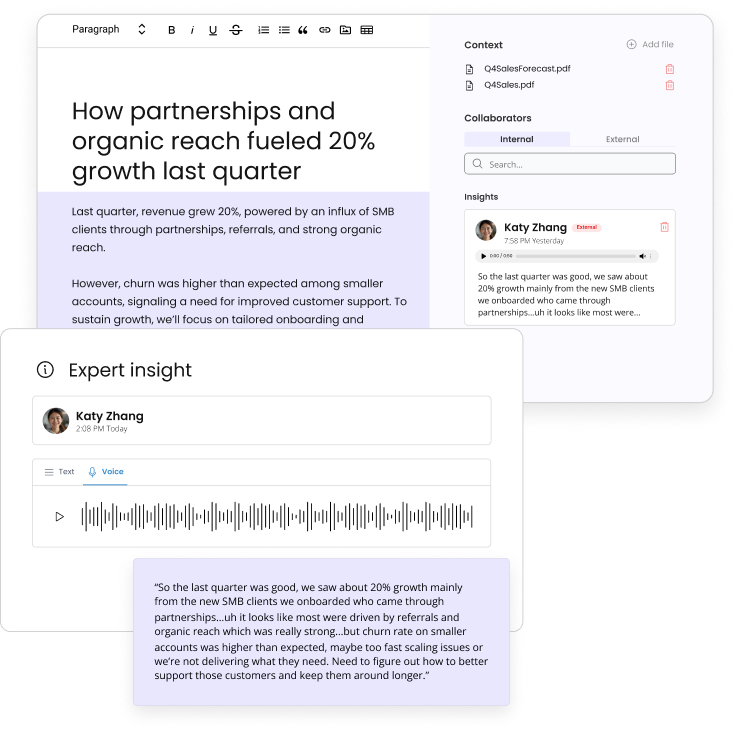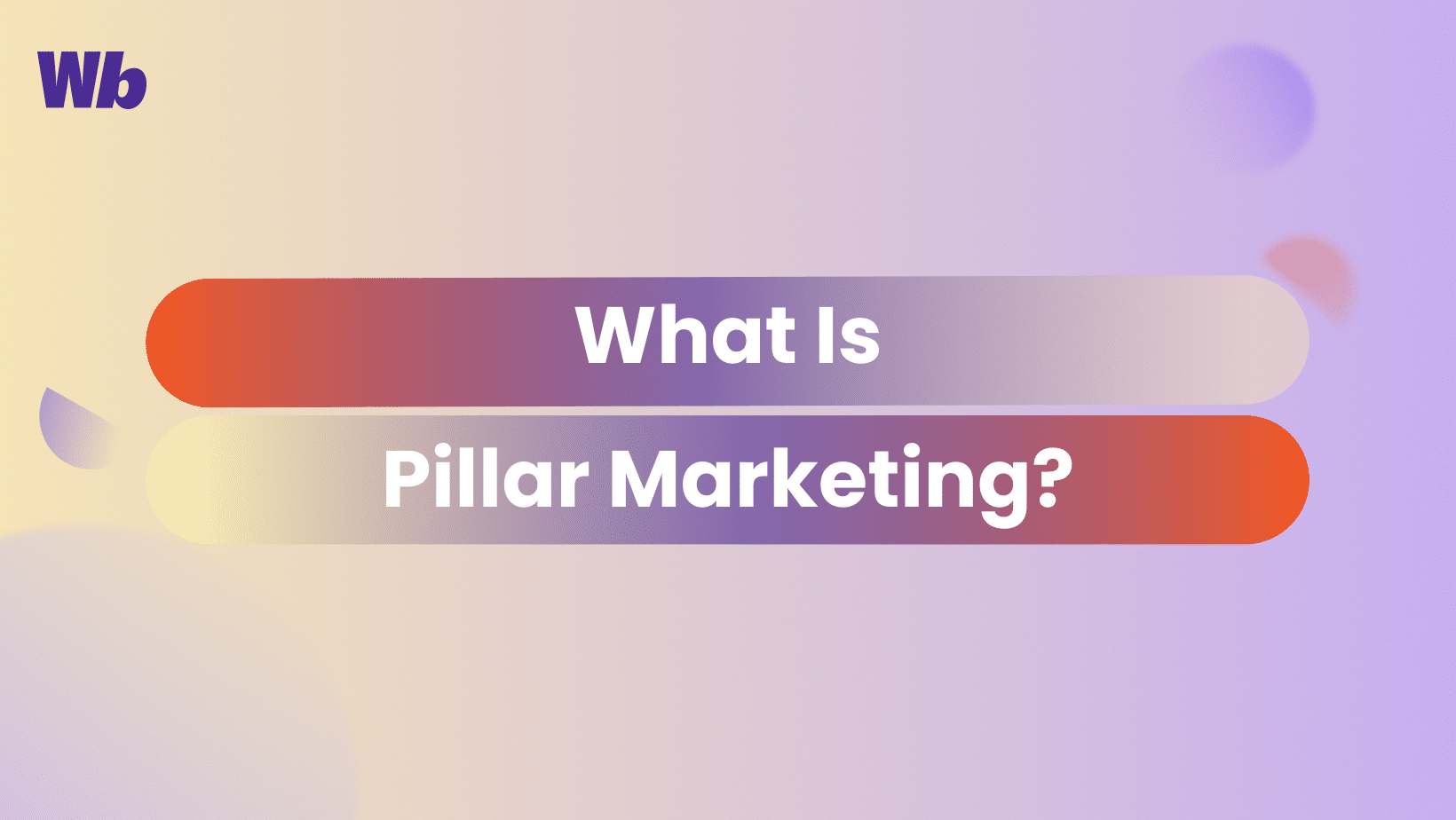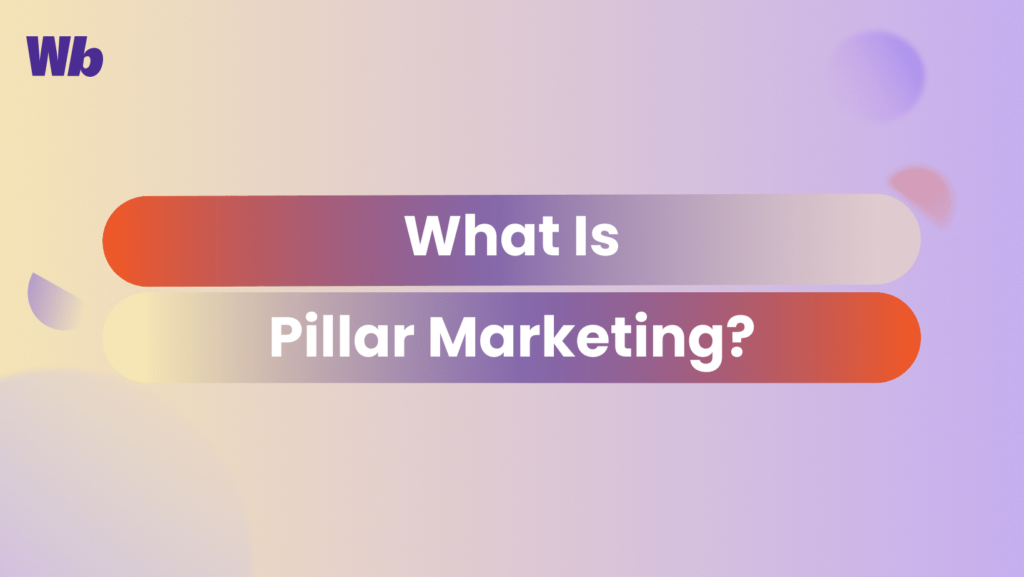Table of Contents

Authority scales when expertise comes first
Wordbrew helps teams collect expert insight before AI ever writes a word.
Built for expert-led, review-safe content
- Home
- »
- Content Marketing
- »
- What is pillar-based marketing? An organic playbook
-
Stacy Garrels
- 7 minutes read time
What is pillar-based marketing? An organic playbook
- Home
- »
- Content Marketing
- »
- What is pillar-based marketing? An organic playbook
What is pillar-based marketing? An organic playbook
Table of Contents

As a content marketing strategy, pillar marketing helps us create engaging content and boosts our chances of appearing at the top of the search engine results page (SERP).
Think of a pillar-based approach as a roadmap: pillar topics are the destination, pillar pages are the highways, and support content acts as the side roads, connecting everything.
This structure makes your content easier to navigate, resonates with your target audience, and improves search rankings by aligning with search engine expectations and linking your pages together.
But building this roadmap isn’t just about content ideas; it’s about structuring your strategy for readers and search engines.
Let’s talk about pillar-based marketing, how it works, and how you can use it to create content that performs.
TL;DR
- Pillar-based marketing is a content strategy centered on a comprehensive pillar page (hub) linked to related support content (spokes).
- Pillar page: Covers the main topic broadly.
- Support content: Explores subtopics or answers specific questions.
- Internal linking: Connects all content, forming a cohesive content cluster.
- Pillar marketing signals topic authority, improves user experience with easy navigation, and drives organic traffic and long-term growth.
What is pillar-based marketing?
Pillar-based marketing, also referred to as the hub-and-spoke model, is a content strategy built around high-value, interconnected content:
- Pillar pages provide a broad overview of a core topic.
- Support content dives into subtopics, answering niche questions.
- Internal linking ties everything together, helping both users and search engines.
Together, they create a content web that connects ideas and helps both readers and search engines find what they’re looking for.
This approach does more than organize your content—it establishes authority. Covering a topic from every angle tells search engines that your site is the ultimate resource for that subject.
Want to stand out in search results? Create content that works together, not in isolation.
Traditional content marketing vs. content pillars
In traditional content marketing, you create and share articles, videos, podcasts, and other social media to attract and retain your audience. If you want to establish authority and create long-term growth, adding a pillar-based marketing strategy gives you the structure and scalability to succeed.
You can scale a pillar strategy by adding new sub-pillar pages or blog posts without disrupting existing content.
💡 Learn more: Top Content Marketing Principles to Turn Clicks into Customers
Why pillar-based marketing matters
Great content doesn’t automatically show up in search results—it earns its place. That’s where pillar-based marketing comes in.
Here’s why this strategy works:
1. Strengthens SEO performance
Search engines love organized content. Linked pillar page and support content work together to signal relevance for key search terms, driving more organic traffic.
2. Improves user experience
Ever landed on a page and struggled to find the information you needed? With a pillar strategy, readers can navigate between a main pillar and related topics, finding answers faster.
3. Establishes authority
Comprehensively covering a subject shows readers and search engines that you’re an expert and trusted resource for your topic.
4. Drives organic search growth
Broad pillar topics attract attention, while focused sub-pillar articles capture niche searches. They increase your reach across diverse search behaviors.
5. Aligns with business goals
When your content strategy is structured, every piece has a purpose. That means less wasted effort and more focus on creating content that drives business growth.
Pillar content and EEAT
Everyone knows that to get your page seen, you need to to place well in Google search results. Google is the largest and most popular search engine in the world, with an 89% market share.
The good news is that Google was kind enough to share some guidelines on how to get in their good books: Experience, Expertise, Authoritativeness, and Trustworthiness (EEAT). Your pillar page and content clusters should satisfy these requirements if done right.
How to get started with pillar-based marketing
Building a successful pillar-based content strategy doesn’t have to be overwhelming. Here’s a step-by-step guide to creating content that drives results:
1. Identify your core topics and target audience
Start with core topics that align with your business goals and resonate with your target audience. Topics should be broad enough to create a comprehensive pillar page but specific enough to focus your support content.
“When you create pillar content, you should identify cluster topics, keywords and outlines at the same time,” explains Ashish Goswami, Sr. SEO Analyst at Krish TechnoLabs.
Use the hub-and-spoke model to organize content around a central pillar page (the hub) that links to and from related support content (the spokes).
“We set up our Holistic Wellness Practices page to cover common health problems and link to diet, yoga, and mindfulness. Organic traffic went up by 50%, and email sign-ups went up by 40% in just six months. Our rank also went up for keywords that are hard to get, like wellness practices,” shares Jean Christophe Gabler, Publisher & Founder at YogiTimes Boutique. “This taught me that a well-thought-out plan for material could get people to read and, over time, earn their trust.”
Tools like Google Trends or Ahrefs can help you research search volume, related short-tail keywords, and trending topics. Ask yourself:
- What are the key questions your audience is asking?
- Which topics will showcase your subject matter expertise?
2. Create a strong pillar page
Your pillar page is a long-form, in-depth resource that provides value to readers. It should cover the pillar topic broadly with text that can be linked to support content for deeper dives. Add in optimized keywords to target search behavior and boost SEO performance.
Don’t forget to add a table of contents for easy navigation.
3. Develop cluster content
Write support content that answers specific questions or focuses on subtopics related to your pillar material. Frederick Poche, Content Marketer at EssayShark, shares a real-world example, “At a digital marketing agency, we created a pillar page titled ‘The Ultimate Guide to SEO’ and linked it to various cluster content pages like ‘Local SEO Strategies,’ ‘On-Page SEO Best Practices,’ and ‘How to Build Backlinks.’”
Each piece of content should:
- Explore one aspect of the core topic in detail.
- Target niche search terms to expand your reach.
- Link back to the pillar page.
Frederick Poche adds, “This approach helped improve our search engine rankings, increased organic traffic by 40% and generated more leads from potential clients interested in SEO services.”
4. Build an internal linking strategy
Internal linking is the glue that holds your content web together.
- Link each piece of support content to your pillar page and other related articles.
- Update your pillar page with links to support content.
Internal interlinking improves user engagement, keeps readers on your site longer, and signals to search engines that your content is interconnected.
5. Optimize for SEO and track performance
SEO doesn’t end with publishing. Use tools like Google Analytics and Search Console to monitor:
- Search rankings for your target keywords.
- Changes in organic traffic and search behavior.
- User metrics like time on page and bounce rates.
“We analyze the relationship between supporting content—such as blog posts or videos—and the pillar page. If a blog post ranks for a related long-tail keyword and drives traffic to the pillar, it reinforces the value of the entire cluster,” says Wes Wakefield, Founder at Pro Coffee Gear.
“We also monitor backlink growth, as high-quality links to a pillar page signal authority and relevance,” he adds.
Common mistakes to avoid in pillar-based marketing
Even the best strategies can fall short without proper execution. Here are common mistakes people make when implementing a pillar-based content strategy—and expert advice on how to avoid them.
1. Skipping audience research
Your pillar topic needs to align with your target audience’s needs and questions. Failing to research their search behavior or interests can result in content that doesn’t resonate—or rank.
“Don’t overlook user feedback and behavioral data. Analyzing how your audience interacts with pillar content—whether it leads to deeper engagement or triggers actions like sign-ups or purchases—helps refine your approach,” says James Hacking, Founder & Chief Playmaker at Socially Powerful. “Consistently measuring performance and adjusting based on those insights makes pillar-based marketing effective.”
Wordbrew tip: Use tools like Google Trends or SEMrush to identify high-value content topics with sufficient search volume and relevance to your audience.
2. Overloading pillar pages with information
“One of the most common mistakes I’ve seen in pillar-based marketing is overcomplicating the structure. Some teams try to build pillars that attempt to cover everything, which often waters down the focus,” explains Dionne Ricafort, Marketing Manager at CSO Yemen.
Wordbrew tip: Keep pillar pages comprehensive but focused. Use sub-pillar pages to cover specific, detailed topics.
3. Weak internal linking
“A common issue is failing to link cluster content back to the main pillar,” shares Charlie Worrall, Digital Marketing Lead at Imaginaire Digital. “Always link clusters to your main pillar to create a clear content hierarchy. This connection is critical for building authority and improving SEO.”
Without strong internal links, your pillar page and support content can’t function as a cohesive content web. This weakens your SEO and frustrates users.
Wordbrew tip: Create a clear linking strategy that connects every piece of content back to the pillar page and other related articles.
4. Low-value topics
“Don’t select your pillars solely based on traffic—they need to tie into your overall strategy,” says Jenna Inouye, Technical Writer & Developer. “Whether it’s because of outsourced agencies or just teams trying to capture low-hanging fruit, the biggest mistake I see is trying to capture pillars that don’t directly align with the organization’s strategies and don’t funnel lead.”
Wordbrew tip: Not every topic deserves a pillar page. Prioritize topics that align with your business goals and have the potential to drive organic search traffic.
5. Treating pillar-based marketing as a one-time effort
Your pillar strategy isn’t set in stone. “The biggest mistake I’ve seen companies make in pillar-based marketing is considering it a one-time project instead of a continuously dynamic strategy. Many businesses create a pillar page and cluster its content while missing out on the ongoing optimization and content refinement,” Jose Gallegos, Growth Marketer at Jose Angelo Studios.
Treating it as a “set it and forget it” project means you’ll miss opportunities to adapt to industry trends and evolving search behavior.
“Pillar-based marketing is a living, breathing content ecosystem that requires consistent nurturing and strategic updates,” adds Jose Gallegos.
Wordbrew tip: Regularly review your pillar material and support content for updates, expansions, or new linking opportunities.
Avoiding these pitfalls will keep your pillar-based marketing efforts effective and scalable, driving long-term business growth and search rankings.
Ready to build your pillar strategy?
Pillar-based marketing is your roadmap to better search rankings, enhanced user engagement, and long-term growth. By structuring your content around pillar topics and linking them to focused support content, you’ll create a scalable framework that delivers results.
Crafting a winning pillar-based content strategy takes expertise, collaboration, and the right tools. Wordbrew’s collaborative content platform pairs automation with human subject matter experts, aligning every piece of content with your brand’s voice and goals. Contact us today to get started.
FAQs
What is a content pillar?
A content pillar is a brief topic that you focus your content around. Just like pillars hold up a building, content pillars hold up a wider content marketing strategy of several pages that link together.
How do you create pillar and cluster content?
As with any marketing strategy, you should identify your target audience’s needs. What problems are they trying to solve, and how might you help them with your expertise?Choose a couple of broad topics, known as pillars, and turn them into comprehensive pillar pages featuring everything-you-need-to-know type content. From there, you can branch off into subtopics with cluster content that links back to the pillar page and optimizes your performance in search engines.
